Physical Geography of India - 1 | Geography for UPSC CSE PDF Download
| Table of contents |

|
| Physiographic Divisions of India |

|
| What is Physiography? |

|
| The Peninsular Plateau Region of India |

|
| FAQs related to Physical Geography of India for UPSC |

|
The best source to study Geography for UPSC is NCERT Textbooks from Standard 6 to 12. Most of the topics are explained in very simple language in the basic textbooks and it’s really helpful for the exam. We have summarized NCERT and top suggested books for UPSC and have created this Guide on Physical Geography for IAS Aspirants.

Physiographic Divisions of India
- The Earth and its landforms that we see today have evolved over a very long time. Current estimates show that the Earth is approximately 4.6 billion years old.
- Over this long period, it has undergone many changes brought about primarily by the endogenic and exogenic forces.
- It is primarily through the interplay of these forces and the movements of the plates that the present geological structure and geomorphologic processes active in the Indian subcontinent came into existence.
What is Physiography?
“Physiography” of an area is the outcome of structure, process, and stage of development. Indian physiography has vast diversity, with the North having rugged topography (mountain ranges, peaks, valleys, deep gorges) and the South has stable lands (dissected plateaus, denuded rocks, series of scarps). The North Indian Plain lies between the north and the south.
Based on these macro variations, India is divided into the following Physiographic divisions:
- The Northern and North-Eastern Mountains
- The Northern Plain
- The Peninsular Plateau
- The Indian Desert
- The Coastal Plains
- The Islands
Watch the Video on Physiographic Divisions of India to understand the Physiography of India better.
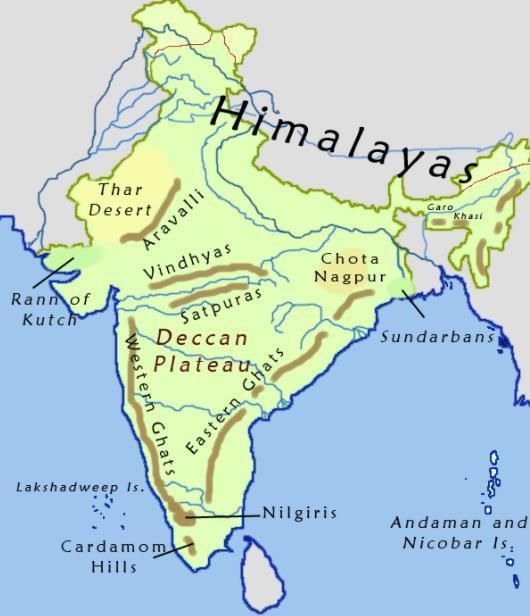 Physiographic divisions of India
Physiographic divisions of India
Choose the correct answer from the codes given below:
(1) structure
(2) process
(3) stage
The North and North-Eastern Mountains of India
This consists of the Himalayas, the Trans Himalayas, and the North-Eastern Hills.
The Himalayan Region of North India
- The Himalayas are a group of parallel ranges of fold mountains.
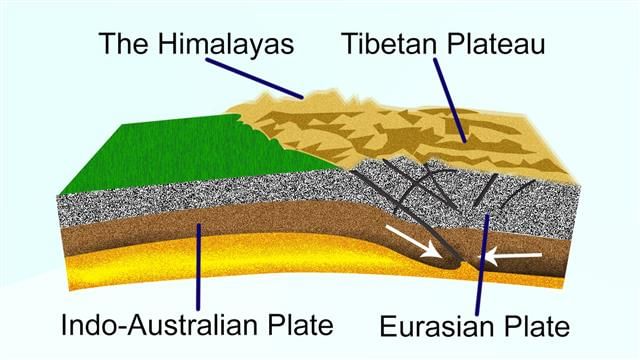 Location of the Himalayas on Earth
Location of the Himalayas on Earth - They are a strong, long wall between India and Central and East Asian countries. They act as a physical barrier and also as a climatic, drainage, and cultural divide.
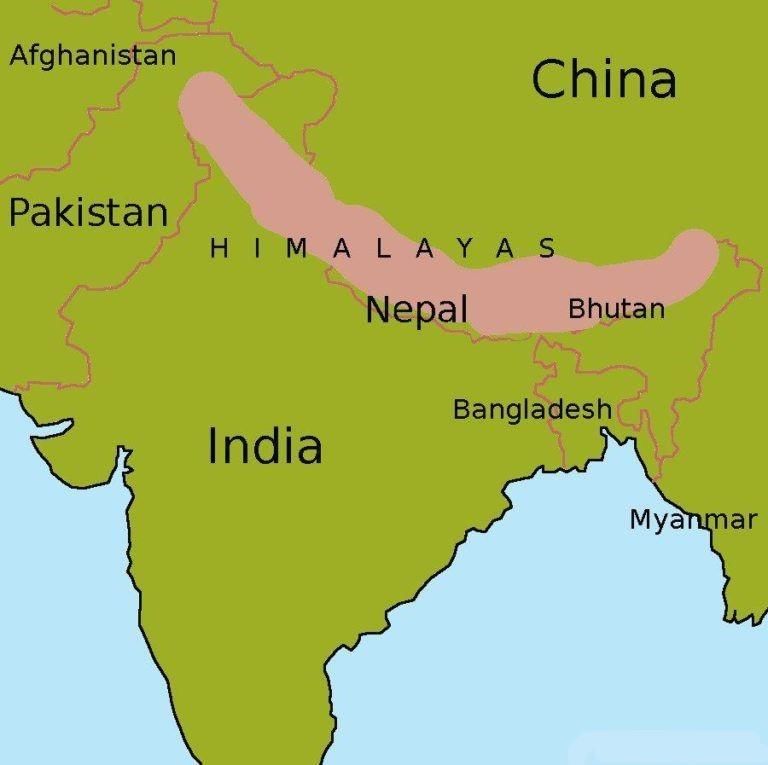 The Himalayas
The Himalayas - It is classified horizontally into the ranges of:
(i) Greater Himalayas or Himadri
(ii) Middle/Lesser Himalayas or Himachal
(iii) Shivaliks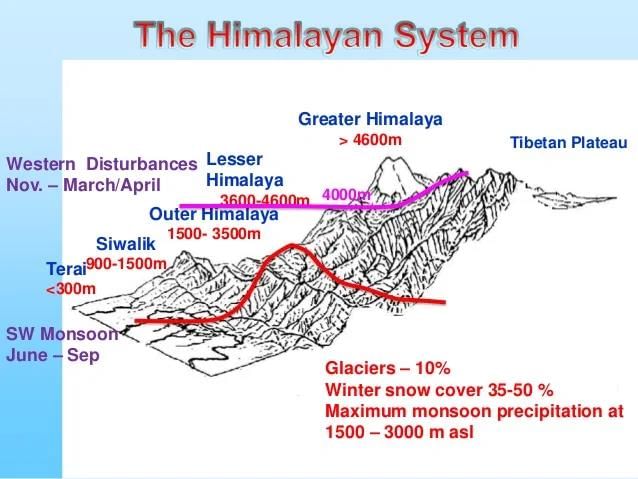 Regionally, the Himalayas can be further divided into:
Regionally, the Himalayas can be further divided into:
(i) Kashmir or North-western Himalayas
(ii) Himachal and Uttarakhand Himalayas
(iii) Darjeeling and Sikkim Himalayas
(iv) Arunachal Himalayas
(v) Eastern Hills and Mountains
The Trans Himalayan Region of North India
- These mountains lie north of the Great Himalayan range and contain some of the highest mountain peaks in the world such as K2, Nanga Parbat, and Gasherbrum. Major rivers such as the Indus and Brahmaputra originate from these mountains. Much of the range is in Tibet and hence they are also called Tibetan Himalayas.
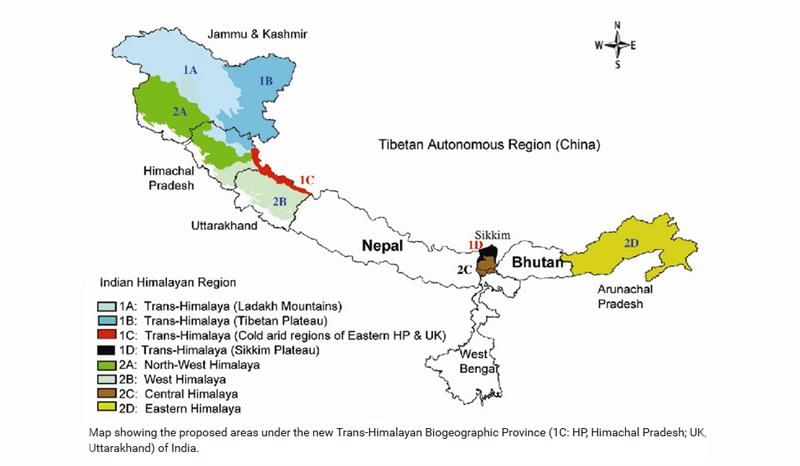
- The Trans Himalayas consists of 4 main mountain ranges:
(i) Karakoram Range
(ii) Ladakh Range
(iii) Zaskar Range
(iv) Kailas Range
The North-Eastern Hills
- These are the southward extensions of the Himalayas running along the north-eastern edge of India. It straddles across the India-Myanmar border. The Patkai Bum, Naga Hills, and Mizo Hills are the main hill ranges.
Have a look at the Mind Map: The Himalayas to get an overview of Himalayan Region, and it will help you to remember it better for your exam.
Which states comprise the Northern Plains Region of India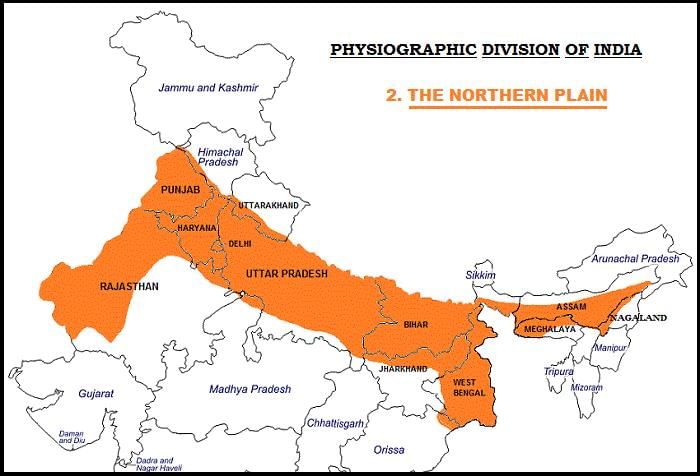
- The northern plains are formed by the alluvial deposits brought by– The Indus, the Ganga, and the Brahmaputra.
- Extension: 3,200 km from east to west.
Width: 150-300 km.
Depth of alluvium deposits: 1,000-2,000 m. - From the north to the south, the Plains can be divided into three major zones:
(i) The Bhabar
(ii) The Tarai
(iii) The alluvial plains ( further divided into the new Khadar and the old Bhangar plains).
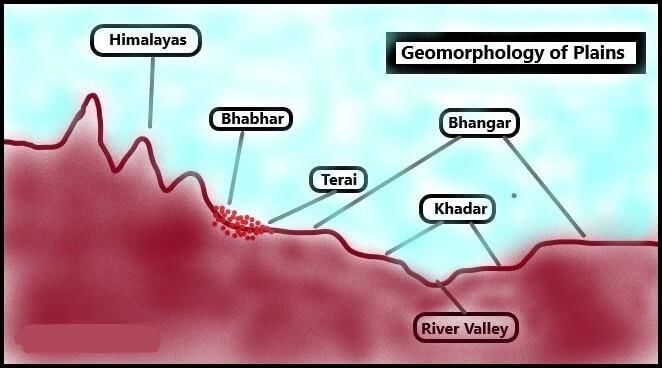 Classification of Northern Plains
Classification of Northern Plains
- These river valley plains have a fertile alluvial soil cover which supports a variety of crops like wheat, rice, sugarcane, and jute, and hence, supports a large population.
The Peninsular Plateau Region of India
- It rises from a height of 150 m above the river plains up to 600-900 m.
- It has an irregular triangular shape.
- Extension
(i) Delhi ridge in the northwest (extension of the Aravalli Range).
(ii) The Rajmahal hills in the east.
(iii) Gir Range in the west.
(iv) The Cardamom Hills in the south. - The Peninsular Region is made up of a number of patland plateaus ( A Patland plateau or Pat is the local name for lava- capped tablelands) such as the Hazaribagh plateau, the Palamu plateau, the Ranchi plateau, the Malwa plateau, the Coimbatore plateau, and the Karnataka plateau.
- It is one of the oldest and the most stable landmasses of India.
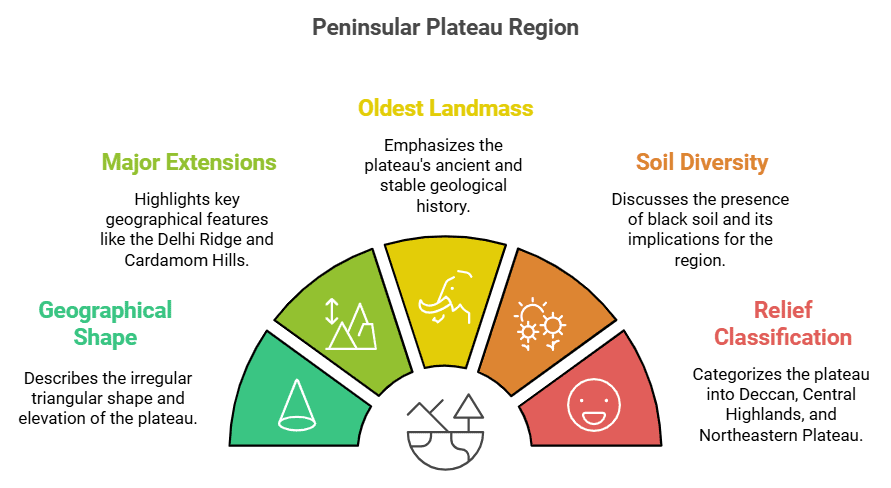
- The western part is loftier than the eastern part.
- The western and northwestern part of the plateau has black soil.
- There is diversity in the relief of the Peninsular plateau: Its northwestern part has a complex relief of ravines and gorges.
Example: The ravines of Chambal, Bhind, etc. - Based on its relief features, the Peninsular plateau can be classified into three groups:
(i) The Deccan Plateau
(ii) The Central Highlands
(iii) The Northeastern Plateau.
What is the Deccan Plateau?
Extent
- The Western Ghats in the west, the Eastern Ghats in the east, the Satpura, the Maikal range, and the Mahadeo hills in the north.
The Western Ghats
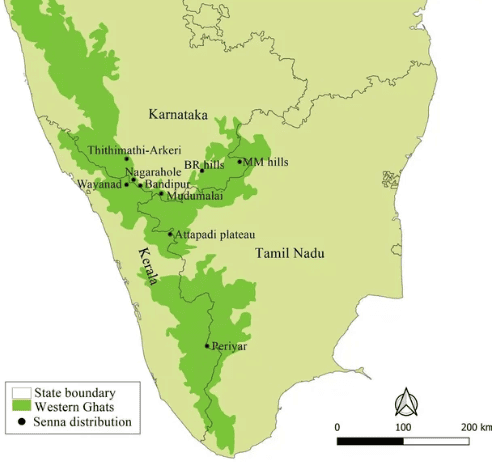
- Locally known by different names such as Sahyadri in Maharashtra, Nilgiri hills in Karnataka and Tamil Nadu and Anaimalai hills and Cardamom hills in Kerala.
- They are higher in elevation and are more continuous than the Eastern Ghats.
- Average elevation: 1,500 m (height increases from north to south)
- ‘Anaimudi’ (2,695 m) is the highest peak of the Peninsular plateau and is located on the Anaimalai Hills of the Western Ghats.
- Most of the Peninsular rivers have their origin in the Western Ghats.
The Eastern Ghats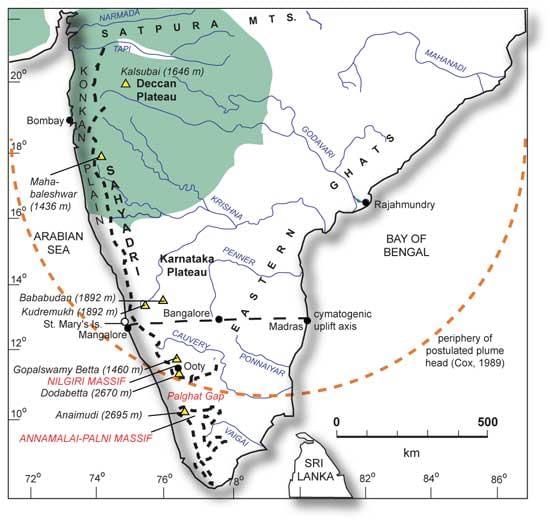
- It consists of discontinuous and low hills which are highly eroded by the rivers such as the Mahanadi, the Godavari, the Krishna, the Kaveri, etc.
- Important ranges: The Javadi hills, the Palconda range, the Nallamala hills, the Mahendragiri hills, etc.
- The Eastern and the Western Ghats meet each other at the Nilgiri hills.
The Central Highlands
- They are bounded by the Aravali range in the West, the Satpura range in the South, and the Rajmahal Hills in the East.
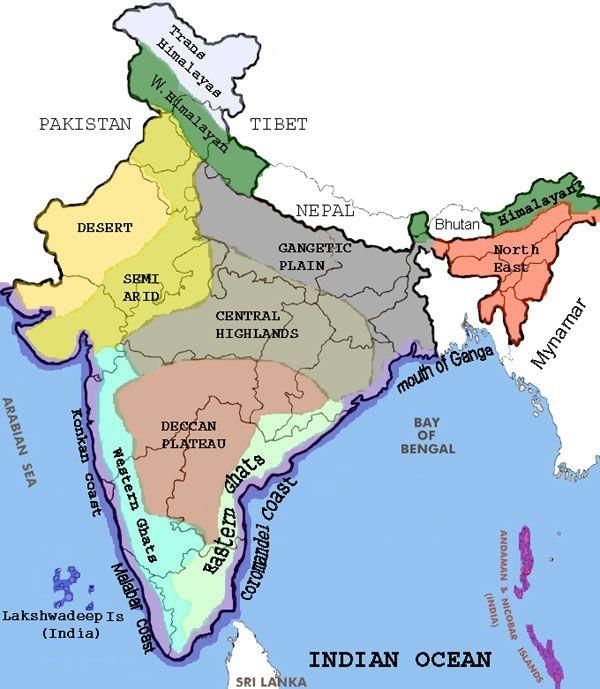
- These are relict mountains that are highly denuded and form discontinuous ranges.
- This region has metamorphic rocks such as marble, slate, gneiss, etc.
- Elevation: 700-1,000 m above the mean sea level.
Northeastern Plateau
- It consists of the Chotanagpur Plateau and the Meghalaya Plateau.
- It is densely forested and populated by many tribal groups.
- The region is rich in mineral resources such as coal, iron, manganese, etc.
- The Meghalaya Plateau is an extension of the main Peninsular plateau and it is believed that a huge fault was created between the Rajmahal hills and the Meghalaya plateau when the Himalayas were formed.
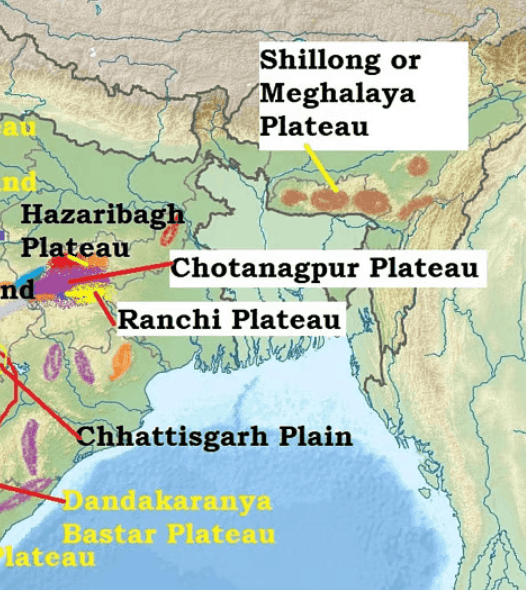
- Later, this depression got filled up by the deposition activity of the many rivers. Today, the Meghalaya and Karbi Anglong plateau stand detached from the main Peninsular Block.
- The Meghalaya plateau is further subdivided into:
(i) The Garo Hills
(ii) The Khasi Hills
(iii) The Jaintia Hills, which are named after the tribal groups inhabiting this region. - The Meghalaya plateau is also rich in mineral resources like coal, iron ore, sillimanite, limestone, and uranium.
- This area receives maximum rainfall from the southwest monsoon. Thus, the Meghalaya plateau has a highly eroded surface. Mawsynram and Cherrapunji in Meghalaya are the wettest places in India.
FAQs related to Physical Geography of India for UPSC
- Is Physical Geography important for UPSC?
In terms of the UPSC civil services test, geography is an essential topic. The UPSC prelims and mains examinations include it. Geography is another optional topic provided by the commission, and it is a hugely popular choice in terms of numbers. - What is India's Physical Geography?
India's topography is incredibly diversified, with snow-capped mountain ranges, deserts, plains, hills, and plateaus among its landscapes. The Indian Plate, which is the northernmost section of the Indo-Australian Plate, is home to the majority of the Indian subcontinent. - What subjects are studied under Physical Geography?
In contrast to the cultural or constructed environment, which is the realm of human geography, physical geography is a field of natural science that deals with processes and patterns in the natural environment, such as the atmosphere, hydrosphere, biosphere, and geosphere.
|
182 videos|620 docs|192 tests
|
















